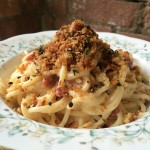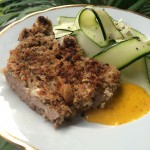A gamekeeper from Navarre
Couldn’t get the birds in the air
People came to shoot
And it was such a hoot
Because the pheasants just sat and stared.
I wasn’t sure whether there were pheasants in the Basque Country, so I wrote a limerick. When things are immortalised in poetry, then it’s half-way to the truth, right?
But then I felt bad about writing such an uninformed post, so I looked it up, and can confirm that there are indeed lots of pheasants in The Basque Country. They’re called ‘faisaia’. So ‘Pheasant Basquaise’ can now join the ranks of ‘Chicken Basquaise’ and ‘Fish Basquaise’ - a one pot wonder, enhanced with a punchy pipérade sauce.
I was keen to develop this dish for two reasons. Firstly because there’s an alarming amount of frozen pheasant in the freezer which needed eating. And secondly because I had lots of pepper which also needed eating.
The problem with cooking pheasant breast is that it dries out so easily and so quickly. Roasting certainly isn’t an option.
Pan-frying is good when the breast is fresh and has been clean taken off. But when pheasant has been frozen as a block then it can look a bit brutal a year on when it’s defrosting in the sink - not so good for pan-frying. Braising is a really good option. The peppery sauce provides moisture, and as the pheasant cooks it releases even more moisture. Simply put the lid on, and stop the ol’ bird from drying out.
The other thing with pheasant is that it’s so often cooked in heavy, creamy sauces. Though it’s a delicious way of serving pheasant on a cold winter’s day, it’s nice to find new, lighter options. The meat is strong and gamey. This pipérade sauce was just perfect. And not only did it use up leftovers, but it was all done in one pan too - so saved on washing up. Frugal on every level.
Pipérade (serves 4 people)
8 tomatoes
2 tablespoons of oil
1 Spanish onion, sliced finely
2 bay leaves
2 green peppers, sliced finely
2 red peppers, sliced finely
3 cloves of garlic, crushed
2 teaspoons of Espelette Pepper (or paprika)
1. Boil a pan of water. Slit a cross in the bottom of the tomatoes, and plunge them in the boiling water for a couple of minutes.
2. Tip out the hot water, and then leave the pan under a running cold tap until the tomatoes have totally cooled. Peel off the skin and discard.
3. Heat the oil in a frying pan, and soften the onions for ten minutes. Add the bay leaves to the pan (to remove later). And then add the peppers, and soften for another five minutes.
4. Add the garlic to the pan and cook for another couple of minutes.
5. Add the Espelette Pepper or paprika, and then add the tomatoes to the pan. Simmer for another ten minutes.
Pheasant Basquaise (serves 4 people)
4 pheasant breasts
84g Prosciutto
1 serving of the pipérade sauce (above)
1. Cut each pheasant breast on the diagonal into about three pieces, so they’re in large, fish finger-sized shapes.
2. Wrap the pheasant pieces in the prosciutto.
3. Heat oil in a frying pan, and then fry them just for a few seconds on either side so that the prosciutto starts to colour and go a bit crispy.
4. Pour over the pipérade, making small hollows to nestle the strips of pheasant breasts within the sauce.
5. Put the lid on, and cook for about 25 minutes.






Love the limerick!